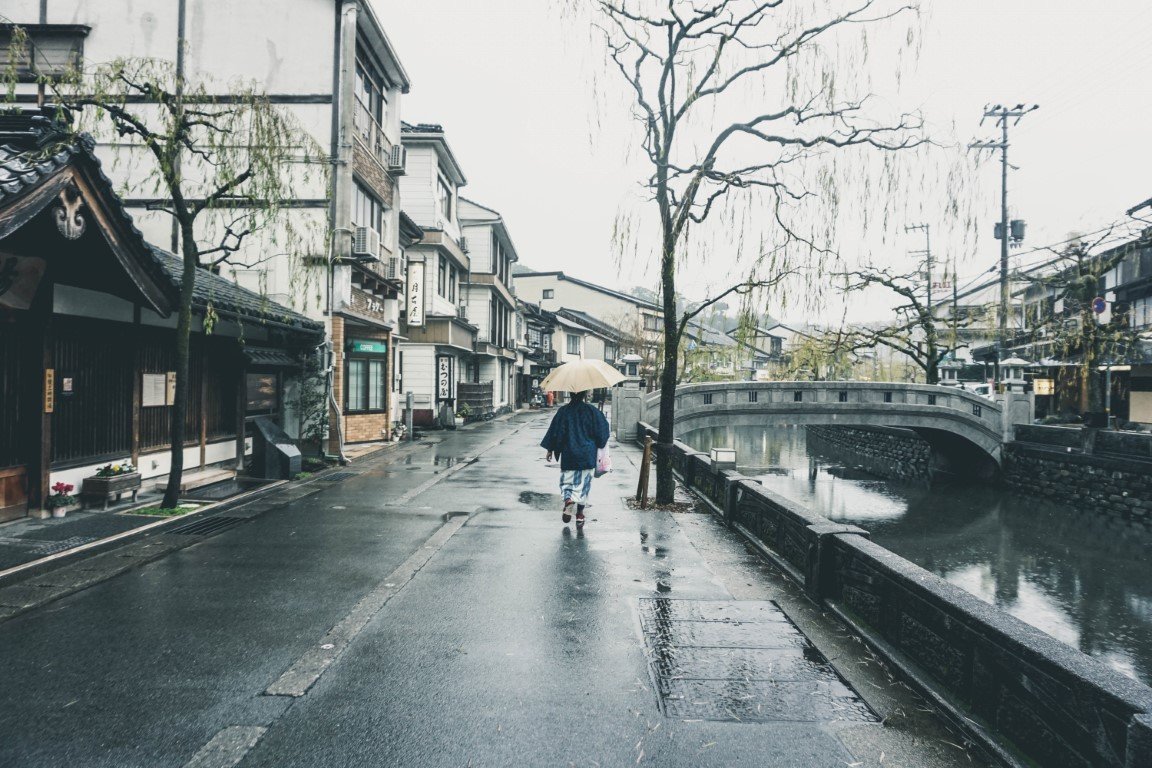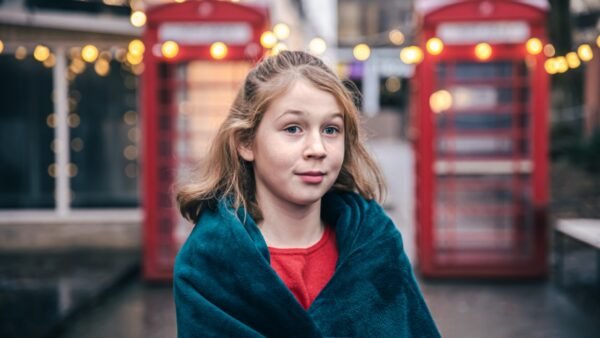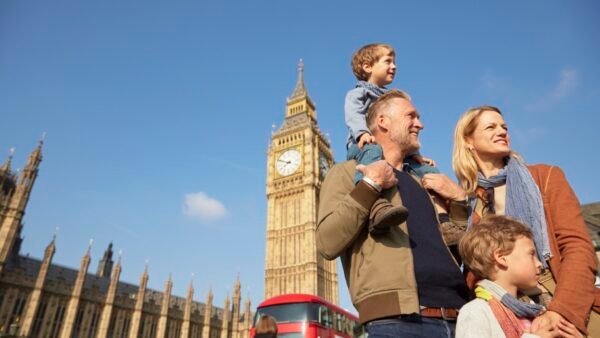One of the most unique experiences you can do on your Japan travel with kids is to go to an onsen town, and Kinosaki Onsen is hands-down among the best. We strolled around the quaint old town in a yukata, stayed at a ryokan, ate Himajima beef and fresh seafood, and went butt-naked in hot springs inside centuries-old public bathhouses. It was one of the best and most memorable things we did as a family.
Onsen and Onsen Town
But first things first: “onsen” literally means hot springs. These natural hot springs used for bathing are all over Japan and they are an important part of Japanese culture. They are known for their therapeutic benefits because of their minerals. And they are a popular way for locals to relax and destress during weekends.
There are different kinds of onsen: indoors, outdoors, traditional, and modern. And they can be inside hotels, ryokans (traditional inns), and public bath houses.
An onsen town like Kinosaki Onsen is a resort town with a concentration of ryokans and private and public onsens. It’s a destination by itself. There are around 25,000 onsens and 3,000 onsen towns across Japan, with each region claiming to have the best one.
Since we were visiting Tokyo, Kyoto, and Osaka, we made a shortlist of onsen towns near these cities. One of those that kept coming up during our online research was Kinosaki. When we saw photos and read reviews, we knew Kinosaki was it!
Kinosaki has been included in Time Out’s top 10 onsen destinations in Japan. It’s also among the recommended top 10 onsen towns by JR Rail Pass. And Lonely Planet named Kinosaki the best onsen town in Japan. It did not disappoint.
Kinosaki Onsen Town
Kinosaki is a 1,300-year-old onsen town famous for its 7 unique public bathhouses, quaint old town feel, and visitors strolling in a yukata (summer kimono). We decided just to stay overnight as we already had a packed 2-week Japan itinerary.
Kinosaki Onsen was founded in 720 A.D. when a traveling Buddhist priest named Douchi Shonin was instructed by a local oracle to pray for a thousand days to save the people from suffering. On the last day, hot spring water came forth and became famous for its healing powers.
This first source of hot spring water became the site of Mandara-yu, the first public bath house in Kinosaki. From then, Kinosaki became a popular onsen destination and became known for its seven mystic onsens.
In 1870, there were already 50 ryokans, attracting visitors across Japan. Yet, it avoided the fate of other onsen towns that became overdeveloped. Instead, Kinosaki preserved its old architecture and onsen culture, such that its residents of some 3,700 live and work there along with thousands of tourists who come and go.
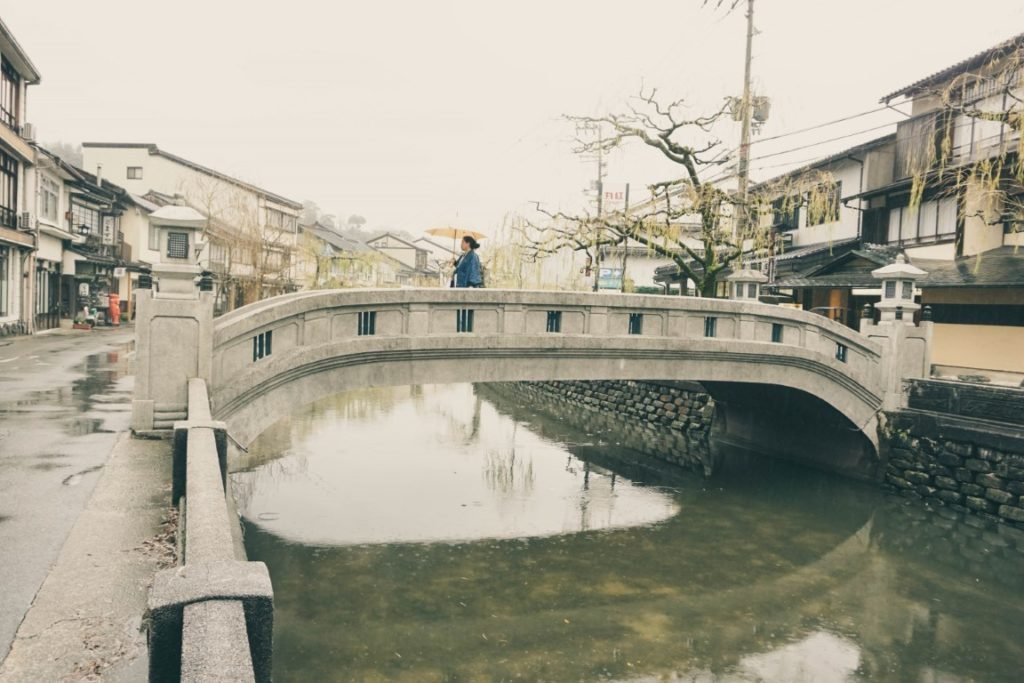
What to Do in Kinosaki Onsen?
Kinosaki Onsen can be a day trip where you can try out a couple of the onsens. But the best way to experience Kinosaki is to stay at least overnight and visit three or four public bathhouses. In hindsight, we could have stayed two nights and gone seven for seven. But a day and a half were enough to immerse ourselves in Kinosaki.
For a small, compact town that you can explore by foot in 20 minutes, there are surprisingly lots of things to do in Kinosaki. These are our top 7 favorite activities in this 7-onsen town:
- Visit as many onsens as you can.
- Stay at a ryokan.
- Stroll the streets in a yukata.
- Explore the old town.
- Eat local treats, Himaji beef, and seafood.
- Buy souvenirs.
- Take loads of photos.
Let’s go over each one by one.
The 7 Kinosaki Onsen Bathhouses
Kinosaki has 7 mystic onsens, some are centuries old. While there are other onsen towns in Japan, Kinosaki is unique in that it is the only one with several bath houses that are distinct in style and that are within walking distance from each other. In fact, Kinosaki practically invented the concept of “onsen hopping.”
Some ryokans in Kinosaki have their own private onsen, but if time is limited, skip that and visit the public bathhouses instead. Take note that this was how the locals used to bathe daily, so this is one way to immerse yourself in their culture.
A public bathhouse is called a sotoyu, and each sotoyu in Kinosaki uses natural hot spring water. Each one also has a unique architectural style and special features, such that your experience at one is different from another. You can do an onsen meguri (or pilgrimage) and do all 7 bathhouses. But if you’re pressed for time, prioritize 3 or 4 and you will already feel you did not miss out anymore.
We knew it was unrealistic to be able to visit all 7, so we did our research and settled for 5. We were there on a Tuesday and Wednesday, and because some of them were closed on either day, we ended up doing only 3.
These are the 3 onsens we visited:
1. Ichino-yu
This was on top of our list because (a) it’s the grandest-looking, resembling a Kabuki theater, (b) it featured an outside cave bath (very unique), and (c) it was in the center of the town, so it was very convenient. This was also the first we visited and the only one our kids experienced. It was quite memorable because they were freaking out about being naked with strangers, but after a couple of minutes, they were able to enjoy the onsen like a local.
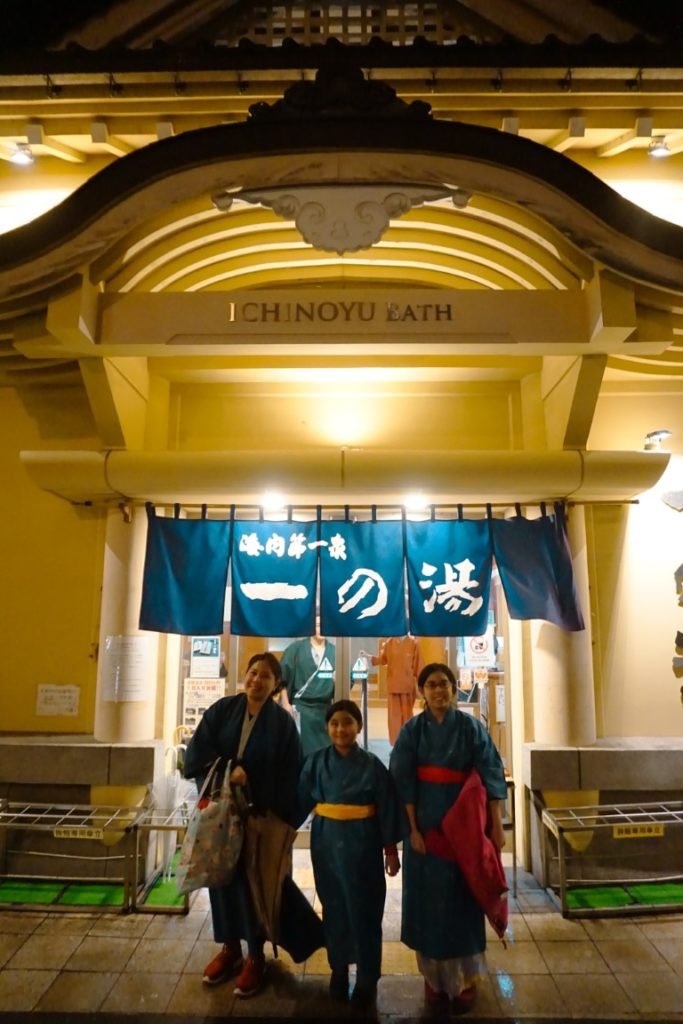
2. Mandara-yu
This was also a must-visit because it’s described as the most attractive-looking. I’m not sure about that as the exteriors look more like a traditional Chinese restaurant. It features a huge indoor onsen. However, the main attraction is the outdoor ceramic barrel baths, where you take turns with other guests. To be able to do this at night, when it was cold, was quite an experience. Mandara-yu is a little off the beaten path, but the narrow path along the canal, lined by old houses, is quite atmospheric.
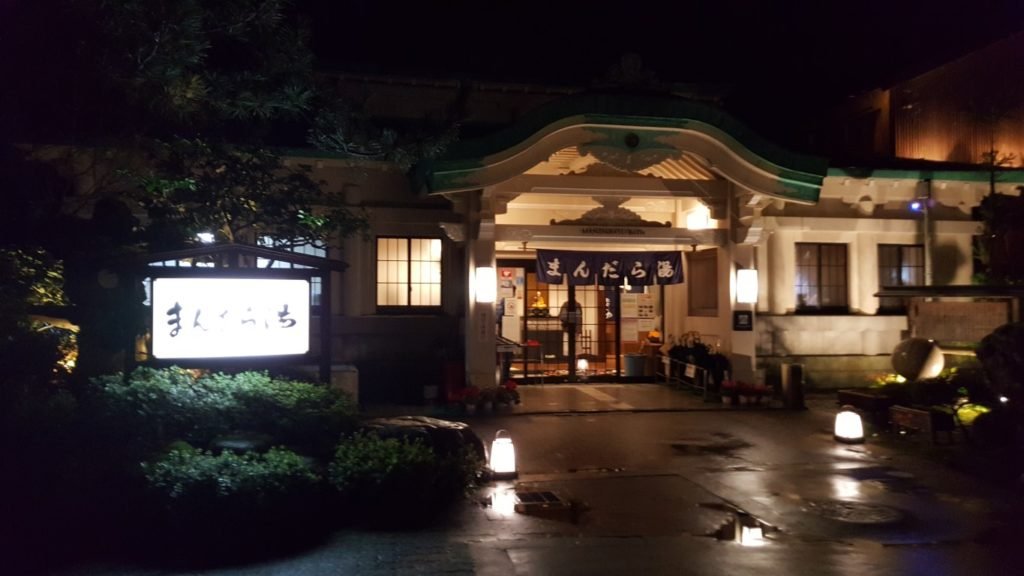
3. Kouno-Yu
You can’t miss Kouno-Yu as it’s the oldest among the 7 onsens. It’s at the far end of the town, but the stroll is picturesque as the streets are lined with cherry trees. The real draw is the large outdoor stone-lined onsen beside a woodland-covered hill. Inside, there’s also a large indoor bath with floor-to-ceiling windows overlooking the outdoor bath. We went there early morning, so it was a beautiful, relaxing, and almost heavenly experience.
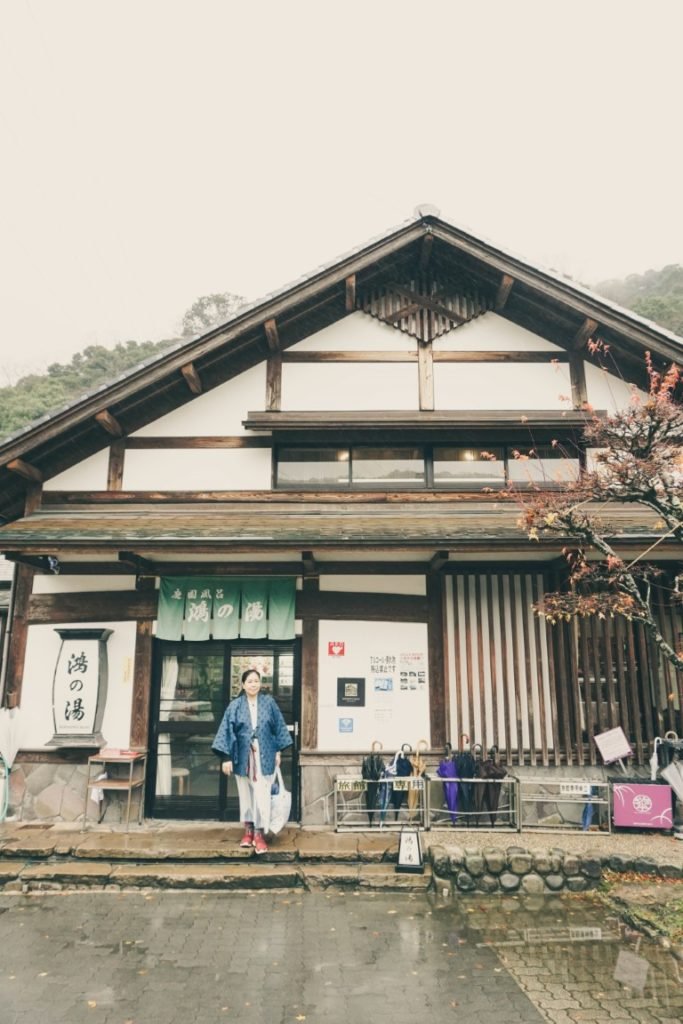
The 2 we shortlisted but did not visit:
4. Satono-Yu
This is the largest bathhouse in Kinosaki, with several baths to choose from. There are Japanese and Western-style baths, a smaller bath, a dry and ice sauna, a jacuzzi, and an open-air bath with waterfalls. Because of its size and its location (it’s right next to the train station), we figured it would probably be the most crowded. As we were pressed for time, we decided to skip it.
5. Goshono-Yu
This was the onsen we really wished we had experienced. But sadly, it was closed for renovation during our visit (it only reopened in November 2020). Now, this was really the most attractive onsen of them all (we did check out the building). The wood architecture with cypress beams and paper walls looks magnificent. Indoors (which we did not see, obviously), there is an outdoor bath with waterfalls.
And here are the 2 we decided to skip from the onset:
6. Jizou-Yu
This is said to be a favorite among locals, but it’s a small bathhouse with no outdoor bath. So, we felt there was nothing unique to it.
7. Yanagi-yu
This is the smallest of the 7 bathhouses. As we did not want to feel cramped with naked strangers, we skipped it.
Kinosaki Onsen Hotels
There are no Western-style hotels in Kinosaki Onsen. However, there are plenty in nearby Toyooka. While technically, Kinosaki Onsen is within the city of Toyooka, it’s actually a 15-minute train stop away.
Toyooka is a good alternative if you don’t want to stay at a ryokan. There are also cheaper accommodations. And the city proper itself is a great place to try local izakayas, pubs, cafes, and restaurants.
Two of the hotels we considered were:
1. Auberge Toyooka 1925
This was at the top of our shortlist. The renovated building was originally a bank, and the hotel looks clean, modern, and gorgeous.
2. Toyooka Green Hotel Morris
Five minutes from the station, it’s a modern business hotel with clean and spacious rooms. But it lacks the personality of Auberge Toyooka 1925.
However, after careful thought, we decided that staying in the city is not the best idea. The reason we decided to visit Kinosaki Onsen is to explore the old town, walk in a yukata, and bathe in the public bathhouses way into the night.
Having to take the train or bus to go back and forth would have been inconvenient, especially as we were staying just for a night. Plus, we wanted to have the full onsen town experience by sleeping at a ryokan. For our kids, this would be their first time, so Kinosaki rather than Tokyo, Osaka, or Kyoto would really be the best place to do it.
Kinosaki Onsen Ryokan
A trip to Kinosaki Onsen would not be complete without staying at a ryokan. This is a traditional Japanese inn where you sleep on futons on the tatami mat floor. Some ryokans have their private onsen, which is nice but not necessary.

Most ryokans also offer breakfast and dinner served in your room. These are delicious multi-course meals called kaiseki that form part of the overall experience. However, they are also quite pricey, so we decided not to include the add-on service. Besides, there are plenty of eateries in Kinosaki to choose from.
As a tourist destination, Kinosaki has dozens of accommodations. Most of the ryokans are quite expensive.
10 Best Value Kinosaki Onsen Ryokans
Start by looking at the top 10 best value ryokans in Kinosaki Onsen, according to TripAdvisor:
- Morizuya (4.5 stars)
- Kinosaki Onsen Kinosaki (4)
- Kinosaki Onsen Nishimuraya Honkan (4.5)
- Kinosaki Yamamotoya (4.5)
- Mikuniya Ryokan (4.5)
- Tajimaya (4)
- Tsukimotoya Ryokan (4.5)
- Kinsui (4)
- Sennen no Yu Gonzaemon (4)
- Kinosaki Onsen Kiraku (4)
Sorting by “Best Value” is better than “Traveler Ranked” as it includes other factors such as ratings, price, location, availability, and user preference. Make sure the average rating is at least 4 stars, and there are at least 20 reviews (the more reviews, the better).
Booking.comThese are our top picks:
Best Splurge: Kinosaki Onsen Nishimuraya Honkan
Kinosaki Onsen Nishimuraya Honkan is at the very high end. The 150-year-old ryokan is considered the best in Kinosaki. It has its own onsen and Japanese gardens. And its kaiseki meals are also considered among the best in the entire region. The rooms have a terrace overlooking the garden views. The pricier suites even have private open-air baths. There’s also a spa. This is the ultimate premium ryokan experience.
Most Authentic Experience: Morizuya
As a family-owned ryokan, you will be greeted by the owners of Morizuya themselves, so it feels like a home away from home. The rooms have either a city or a mountain view. Bathrooms are shared, typical of traditional ryokans. It also has its private onsen. Guests also love the generous kaiseki sets. And your kids will love the room full of the owner’s toys, trains, and tracks. Prices are in the mid-range.
Most Historical: Kinosaki Yamamotoya
This ryokan has a rich 350-year history, which started in the Edo period. The 3-story wooden building is right in the middle of Kinosaki, right beside Ichino-yu. Yamamatoya also boasts of its cuisine prepared by its 40-year veteran chef as well as its own craft beer. The rooms come in different sizes and can fit anywhere from 2 to 6, making it perfect for families.
Best Value: Kinsui
Kinsui is a hidden gem. Well, for one, it was a little hard to find as it’s located in a back alley (but once you’re settled in, it’s no longer a problem to find your way around). But mainly, it’s the only budget-friendly ryokan in Kinosaki Onsen that is highly rated and well-reviewed.
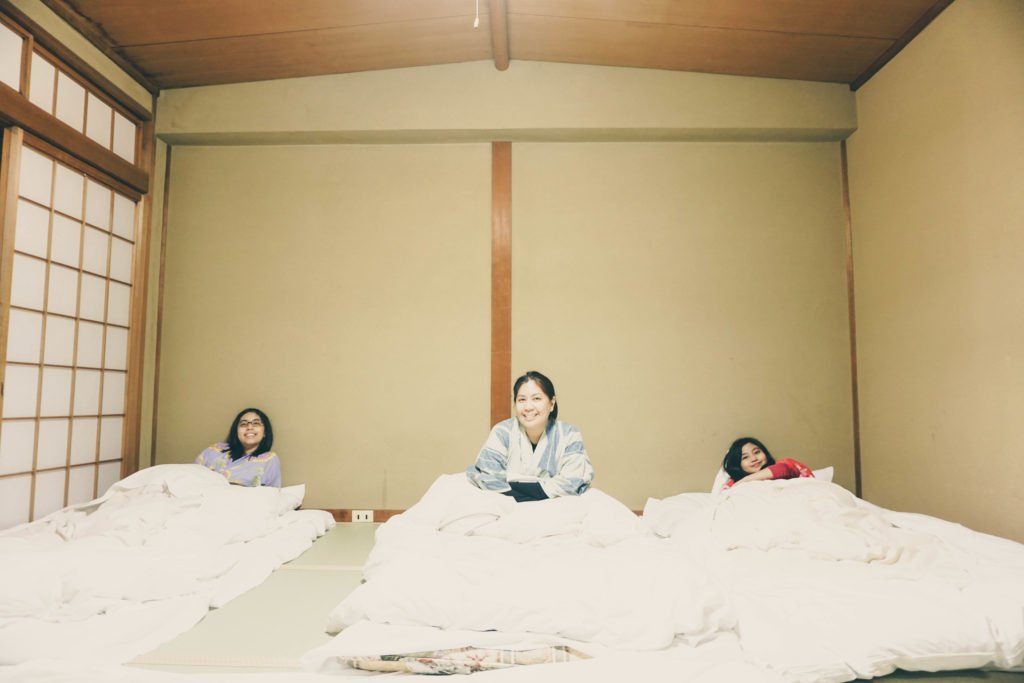
There are two buildings. The main one is more traditional. It serves as the reception area with cozy interiors. It also has a bar and restaurant. The building annex has no staff, so you go in and out as you please (you get a key as it’s automatically locked at night).
When we booked this ryokan, we didn’t really have high expectations, knowing that it was going to be basic. But we actually enjoyed our stay. The room is spacious, clean, and minimalist. There’s a private toilet. Our kids had fun laying out their futons and dressing in their yukata. The area is where the locals actually live. It’s no luxury ryokan but it’s as authentic as can be.
You have to follow some rules when you stay at a ryokan:
Kinosaki Onsen Yukata
Another thing that attracted us to Kinosaki Onsen was photos of people strolling the streets past old, traditional stores in a yukata. It’s like traveling back in time. And this is really the allure of Kinosaki. Especially at night or early morning when there are no day trip crowds, seeing everyone (well, the tourists) walking in their yukata felt natural and authentic, not eye-rolling forced.
What’s a Yukata?
A yukata is like a kimono, except the cotton is lighter as it’s meant to be worn in summer. But as we were there in cold, drizzling December, we wore another layer – a thicker robe to keep us warm. Don’t wear anything under it except your undergarments, as it’s how you should be visiting the bathhouses (robes are easier to take off and put back on).

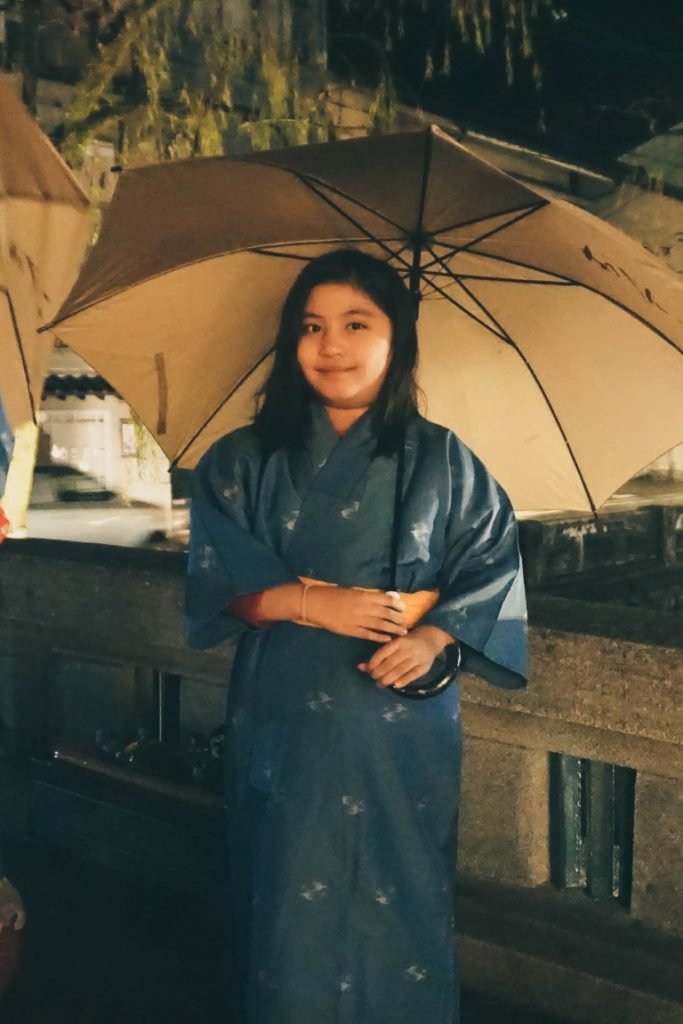
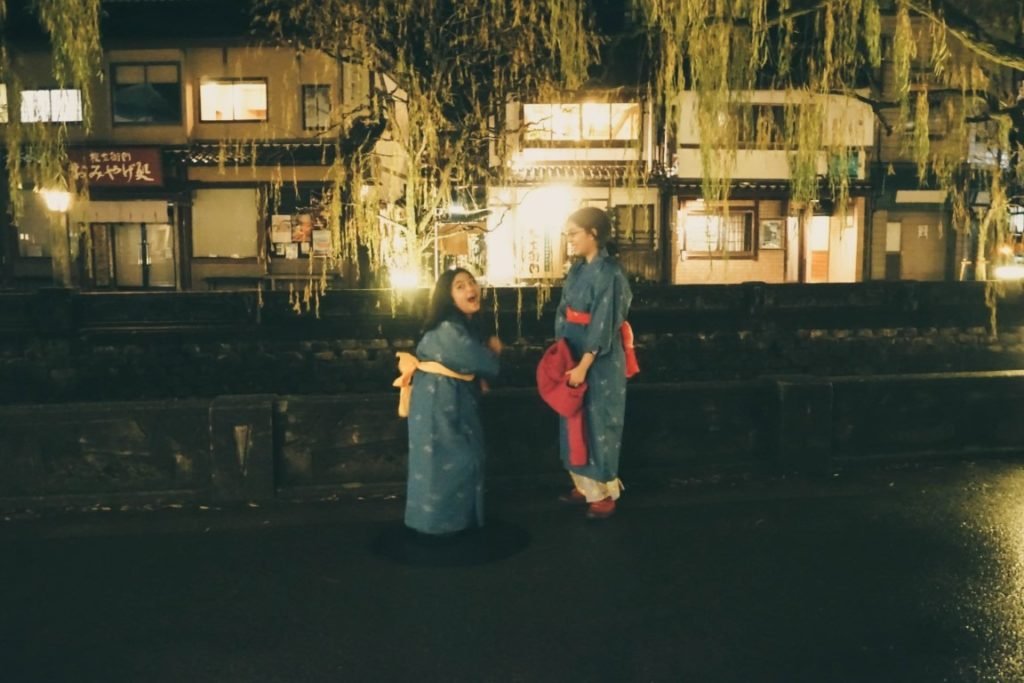
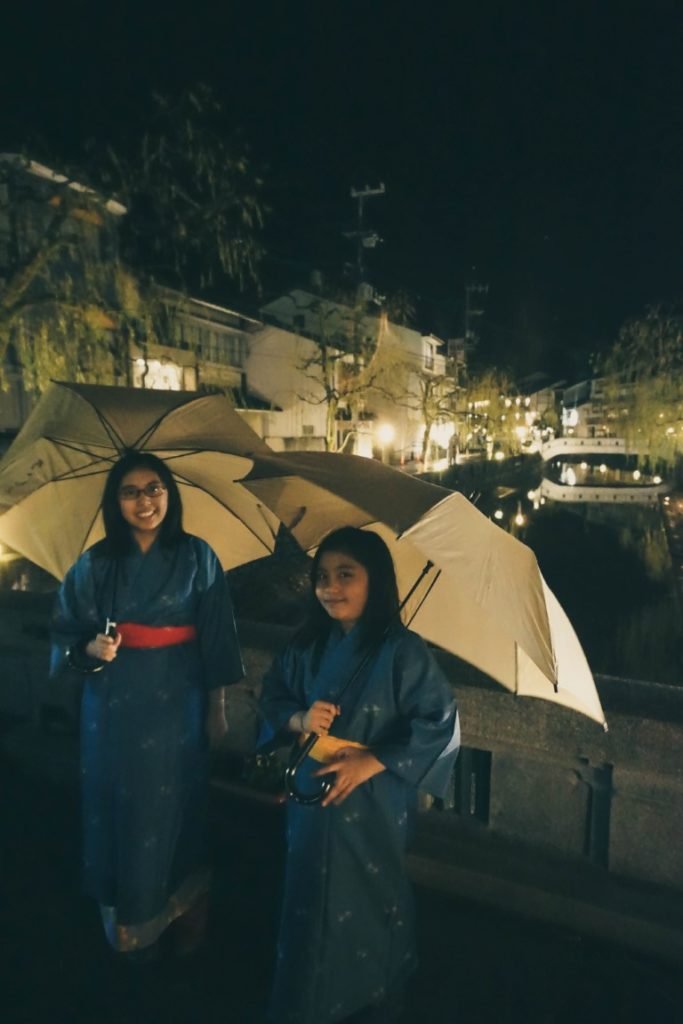
Where to Get a Yukata
Your ryokan will provide you with a yukata to borrow for free during your stay, though you can also rent one if you want something with a different color or pattern. The staff will also teach you how to put it on. Our ryokan also lent us transparent umbrellas. You can also wear the geta, or wooden clogs, to complete the look. You’ll sound like a horse while walking, but it’s part of the fun. And yes, it’s a lot more convenient when you’re onsen hopping.
When to Wear a Yukata
Since the check-out time is usually at 10 am and check-in time is at 3 pm, you won’t see a lot of people wearing a yukata during the day. If you wear one, you will literally stand out from the crowd and perhaps feel ridiculous. So, the best time to wear a yukata is early morning, late afternoon, and evening, when the tourist crowds are gone. This is when Kinosaki is transformed into something more magical.
How to Wear a Yukata
It’s fairly easy to put on a yukata. It’s just like wearing a bathrobe (which it is, literally). But there are a few rules to remember, like not crossing the right side over the left (this is for dead people), not baring your skin, and wrapping it tight so you don’t expose yourself when it’s windy.
You can check out this nifty guide on how to wear a yukata. Or watch this video.
Where to Rent a Yukata
If you feel the basic yukata from your ryokan is not your style, you can rent one that is more colorful and stylish. Your ryokan should have options for you.
Outside, you can go to IROHA Yukata Shop & Rental, a boutique yukata shop in Kinosaki. You can rent or buy from a wider variety of yukata, geta, and tabi (fitted, matching socks). The selection is extensive and the quality is top-notch.
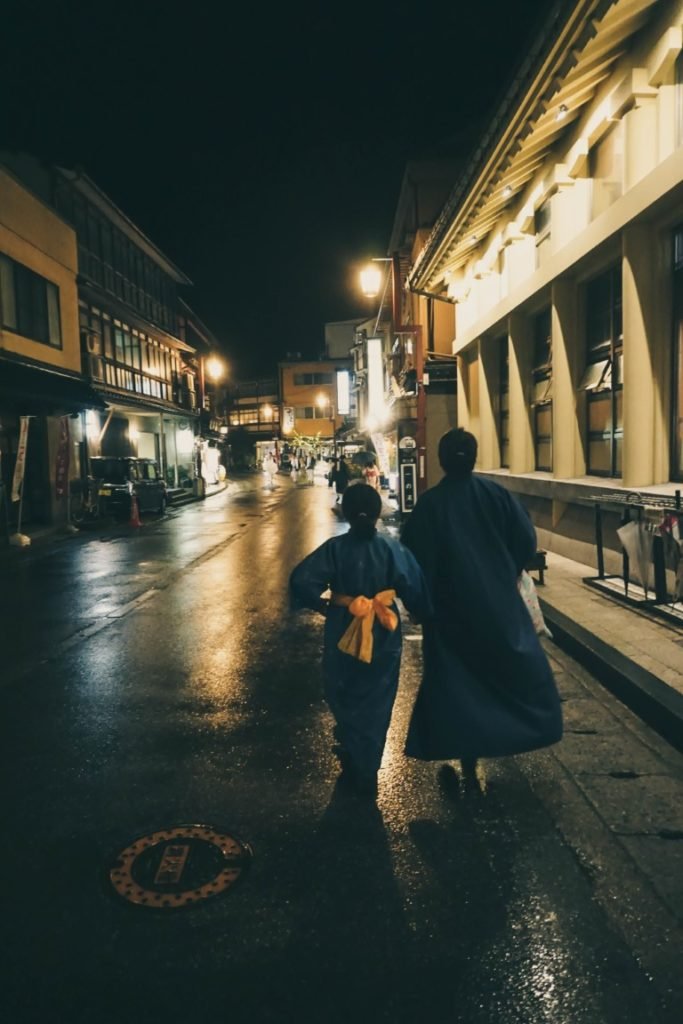

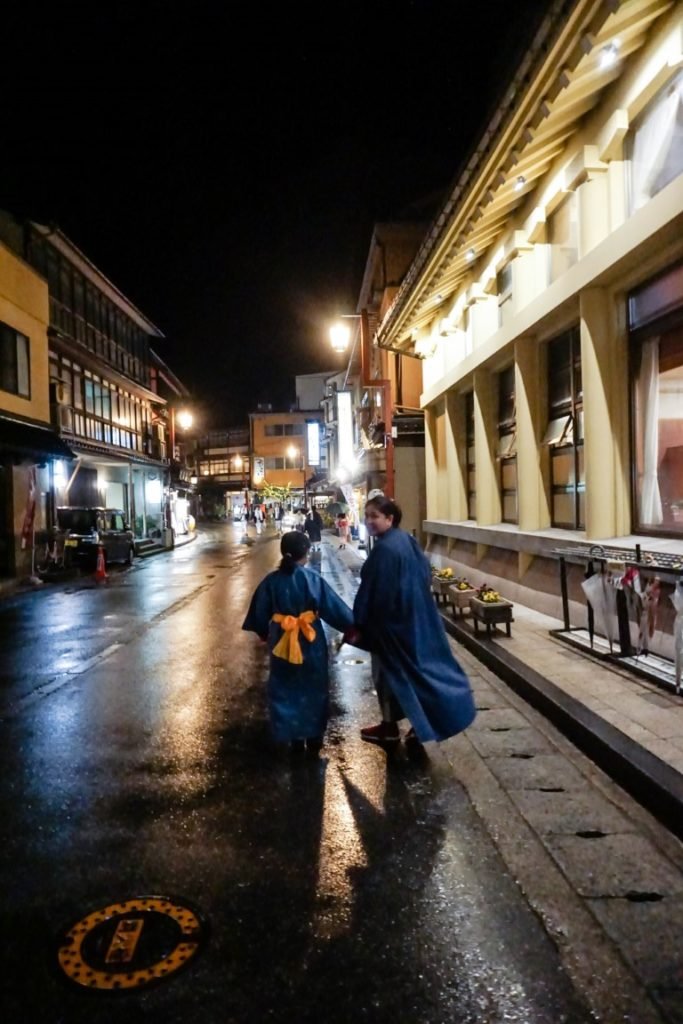
Strolling in Kinosaki Onsen Town
One of the most pleasurable experiences in Kinosaki is just strolling along the streets. It feels nostalgic and romantic walking along the canal of Otani River with the main street lined with cherry and weeping willow trees and street lamps (beautiful, especially at night). There are seven stone arched footbridges across the canal, which add to the old-world charm.
The town’s architecture has been preserved, thanks to local ordinances. So, the traditional low-rise buildings and stores run by small business owners make you feel what it was like to live in Kinosaki centuries ago. At night, you can see the warm glow and silhouettes of guests through the paper windows.
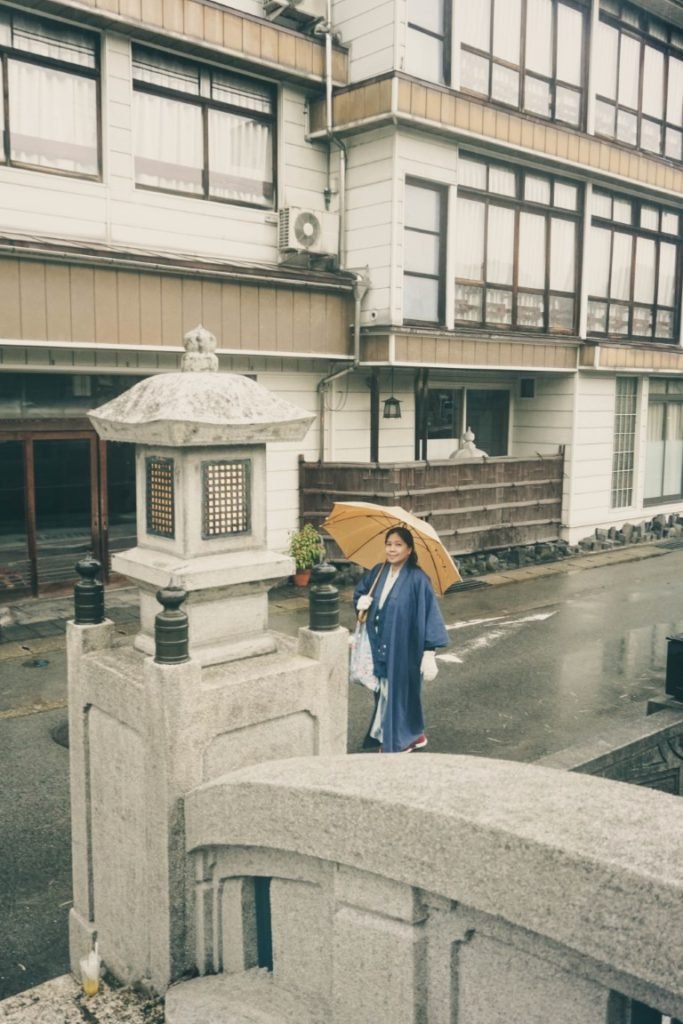



You can also explore picturesque Kiyamchi Street in Kinosaki’s back roads accessible only to pedestrians as well as backstreets and alleyways where the locals go about their daily lives.
Where to Eat in Kinosaki Onsen
Trying out the local cuisine is a must-do for us. And Kinosaki is proud of its unique local food. These are the two things Kinosaki is known for:
Matsuba Crab
Also known as snow crab, this is Kinosaki’s signature winter food. From November to March, seafood markets overflow with Matsuba crab, locally caught from nearby seaports in the Sea of Japan. The snow crab is known for its sweet and fluffy meat and can be boiled, grilled, and mixed in hot pots.
As Kinosaki is close to the coastline, it’s also the perfect place to eat sashimi, sushi, and kaisen-don (seafood rice bowl dishes).
Where to Eat Seafood: Inaba Sengyo
You can’t miss this because there’s a giant crab sculpture on the building’s facade. Inaba Sengyo is a small seafood restaurant beside a fish shop that it owns, so you know the seafood that you order is super fresh. The space is a bit cramped, the chef isn’t very friendly, and the vending machine where you order is in Japanese.
Still, the food is delicious! We had a rice bowl of mixed seafood sashimi while the kids had shrimp and crab tempura-don, which we loved.
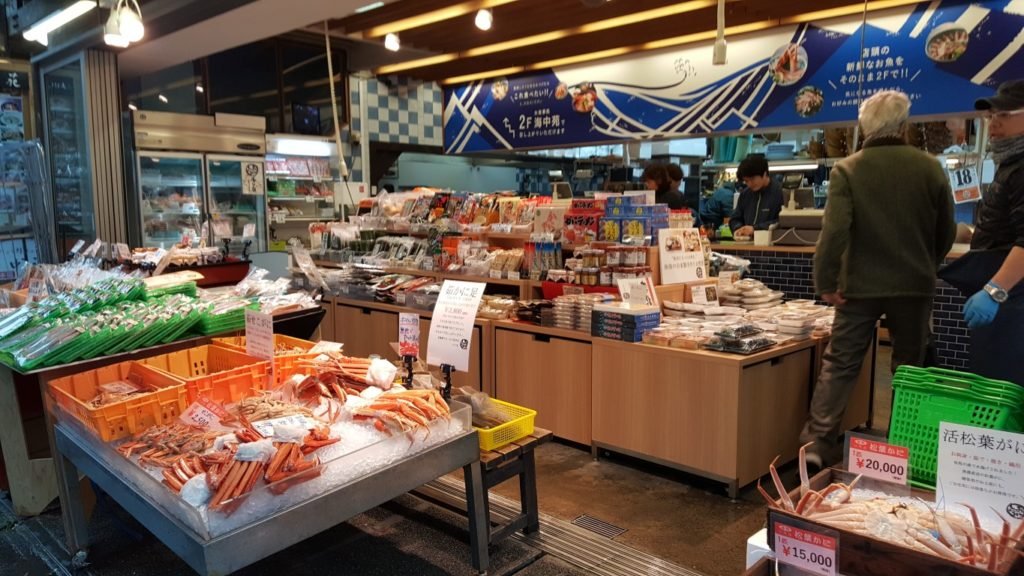
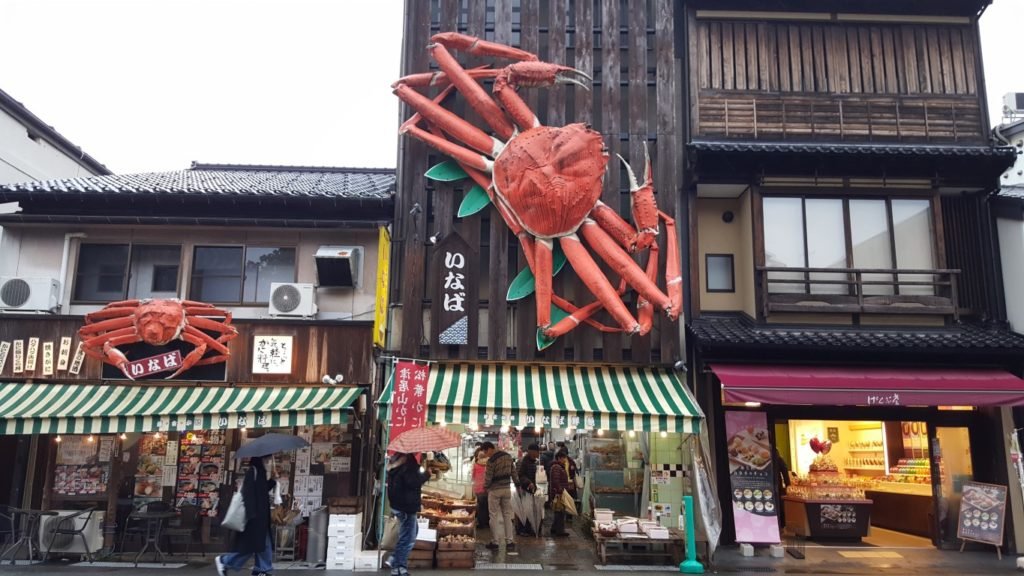
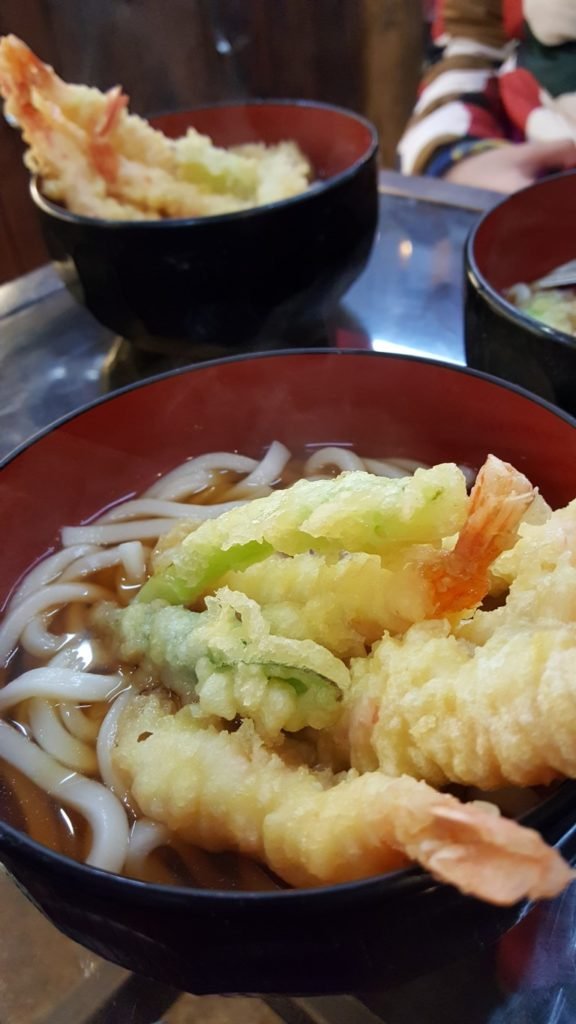
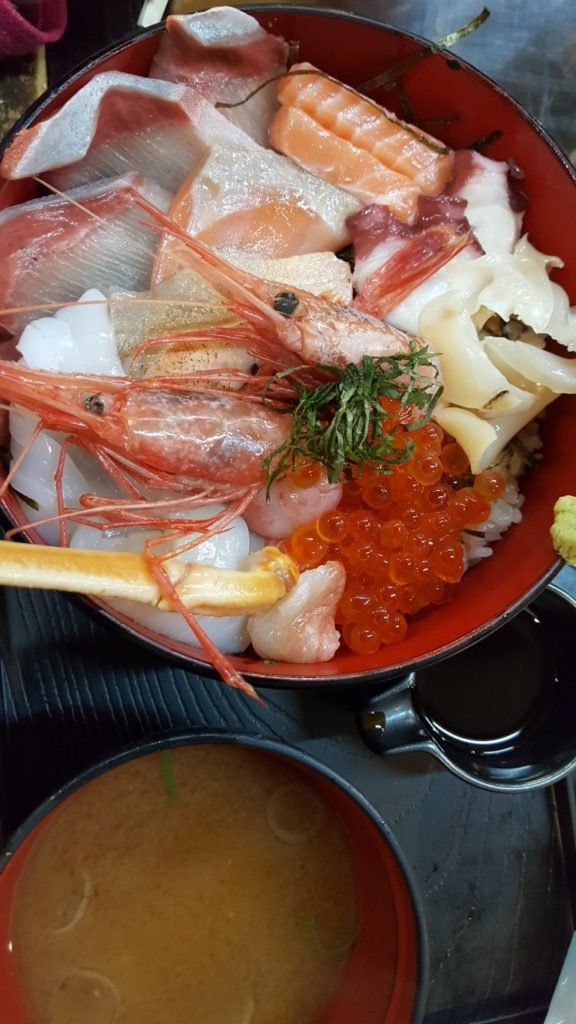
Tajima Beef
Tajima cows, which are Japanese Black cattle, are raised and fattened in Hyogo Prefecture, of which Kinosaki is a part. Authentic Tajima beef is branded as “Tajima beef produced in Hyogo Prefecture.” Tajima beef is known for having the highest percentage and best quality marbling.
Wagyu is just the word for Japanese cattle. It’s not a type of beef. There are official Wagyu breeds, with Japanese Black being the most popular. Among the three bloodlines of Japanese Black cattle, only pure Tajima is certified as Kobe beef. Tajima beef has a Beef Marbling Standard (BMS) of 3 to 5. It becomes melt-in-your-mouth Kobe beef when its BMS is 6 or higher. Only a few thousand cows are certified Kobe, so it’s very rare.
Where to Eat Tajima Beef: Gibugabu
The best place to eat Tajima beef is Gibugabu (which is what people sound like when eating and drinking). The interiors are a blend of rural Japanese country houses with a modern twist. The place has a great view of the canal with its large glass windows.
The menu is kid-friendly (our daughters ordered smoked bacon carbonara and quattro formaggi pizza, which they enjoyed). We had Tajima beef steak and Tajima beef steak rice bowl, and they were as great as they said they were. They also brew their own craft beer (I had stout or black beer). The bill was expensive but totally worth it.

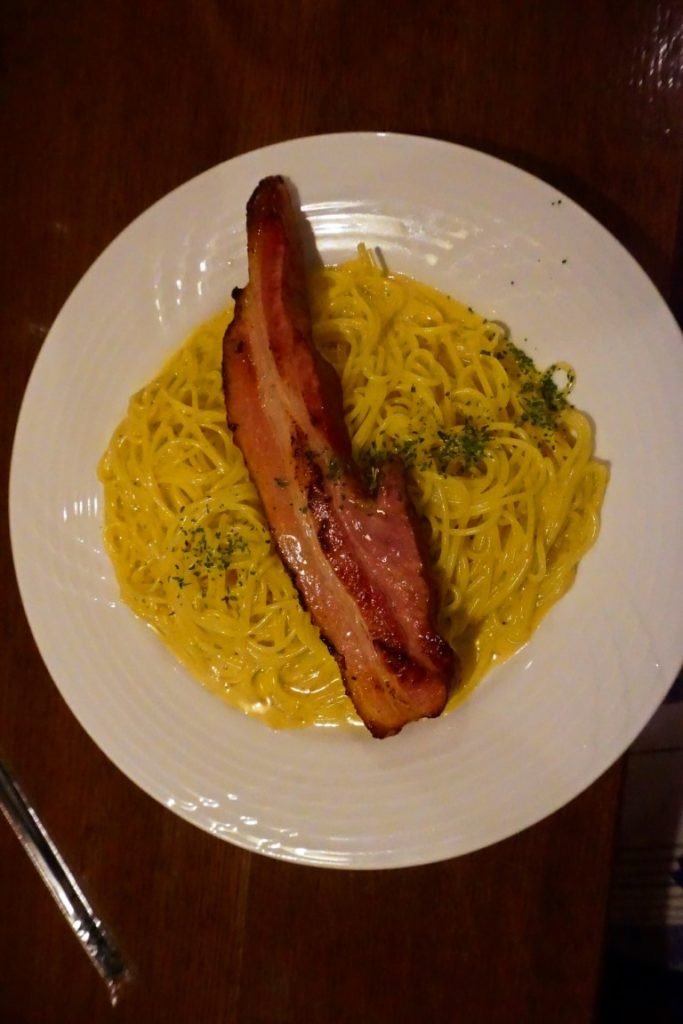
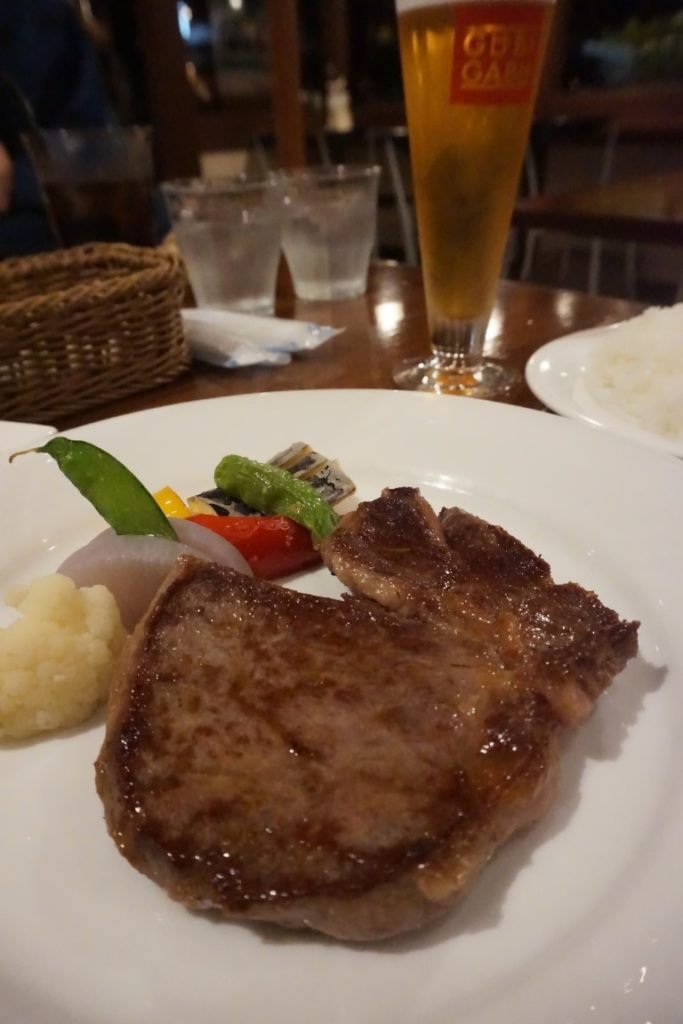
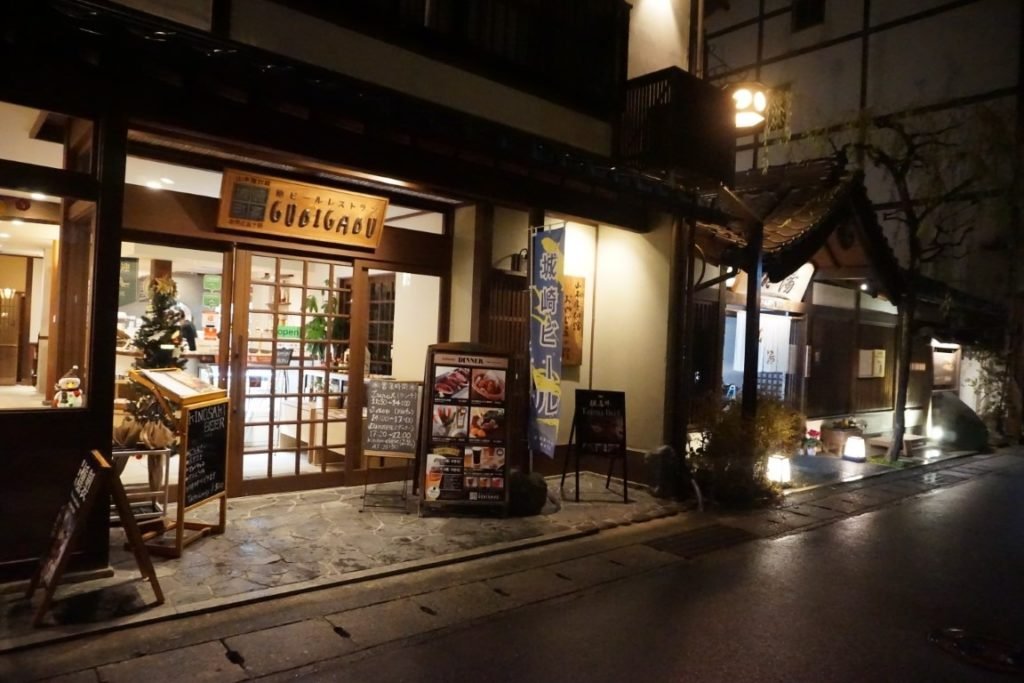
What to Buy in Kinosaki Onsen
Kinosaki is not a shopping destination (which is a good thing). There are no malls here (another good thing), just small souvenir shops and craft stores. There is also a traditionally designed shopping center, but it’s very low-key (no neon signs and blaring music).
Some only-in-Kinosaki souvenir items you can buy are:
- Merch of Gen-san, a local town mascot known for his loveable scowl, Kinosaki beer, Tango Chirimen Silk, Tajimayaki pottery, and many more at Itaya
- Merch of Okenotori, another town mascot representing the famous Oriental White Stork, at Kojinmari
Picture-Perfect Kinosaki Onsen
Make sure to bring a good camera. If you like photography, enjoy posting on Instagram, love to share videos on YouTube or TikTok, or just want to preserve memories with your family, Kinosaki Onsen is a very photogenic and IG-worthy place.
The early mornings are refreshing, and the evenings are atmospheric. Even the busy daytime for pictures is great as the town is more “alive.”
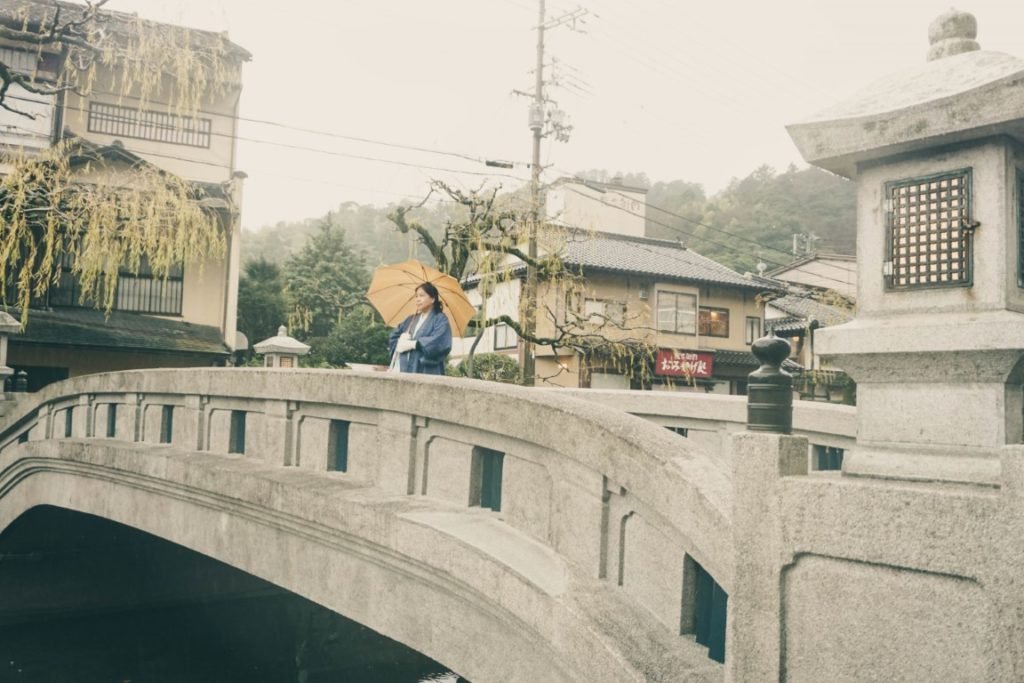
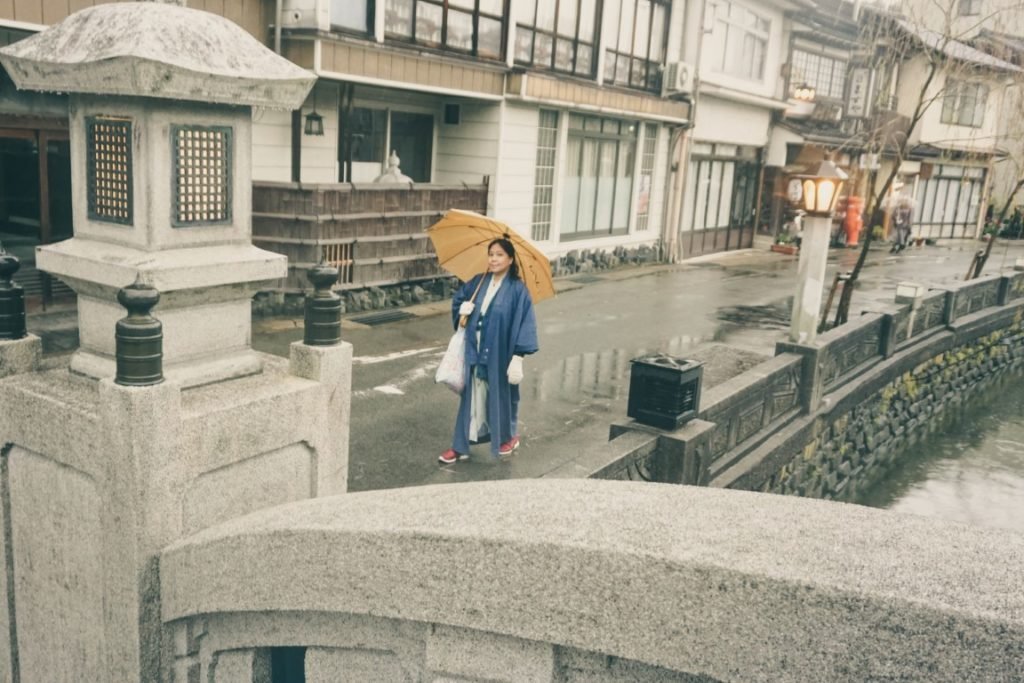
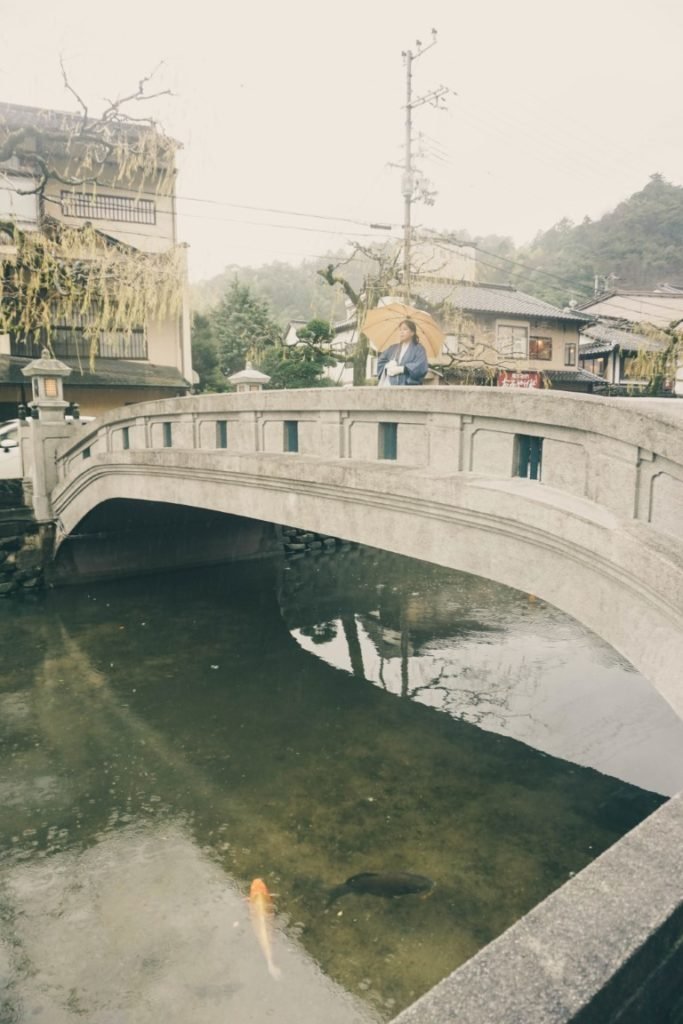

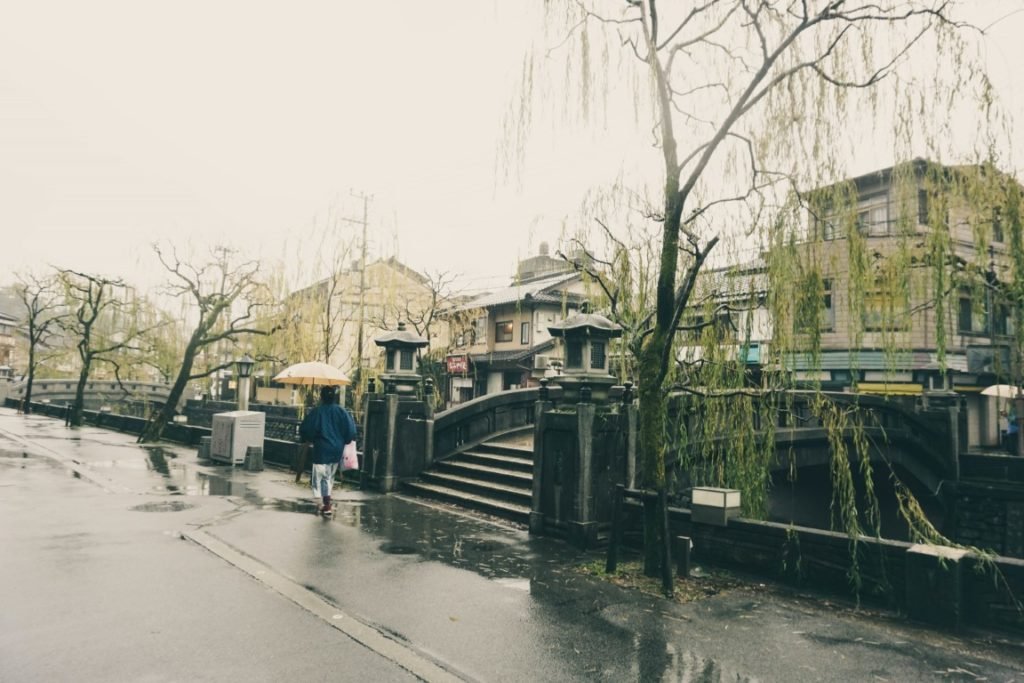


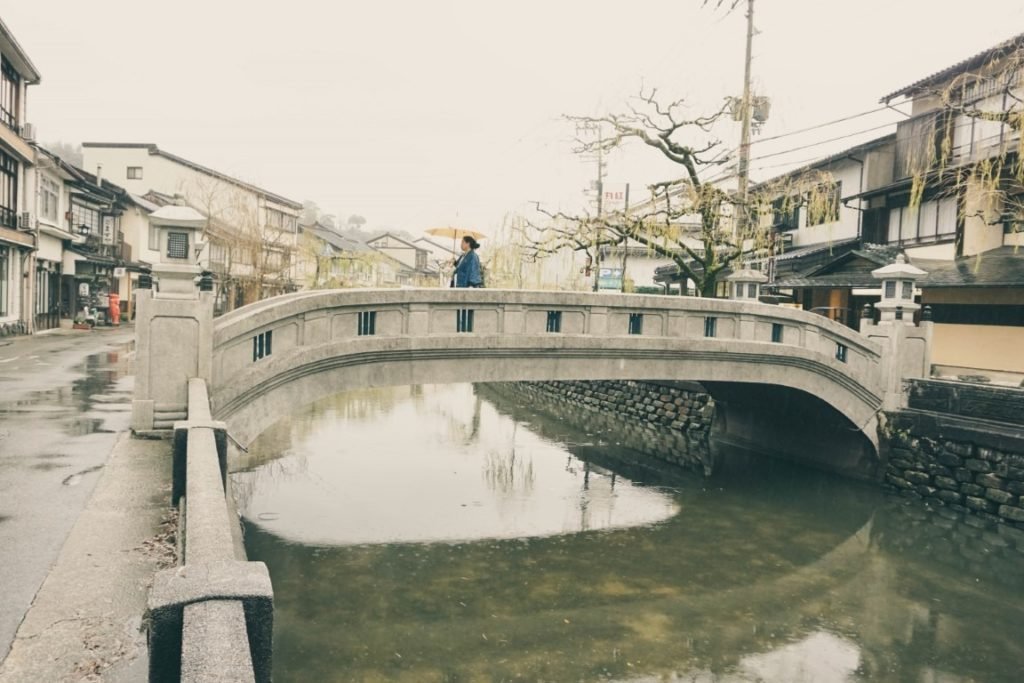
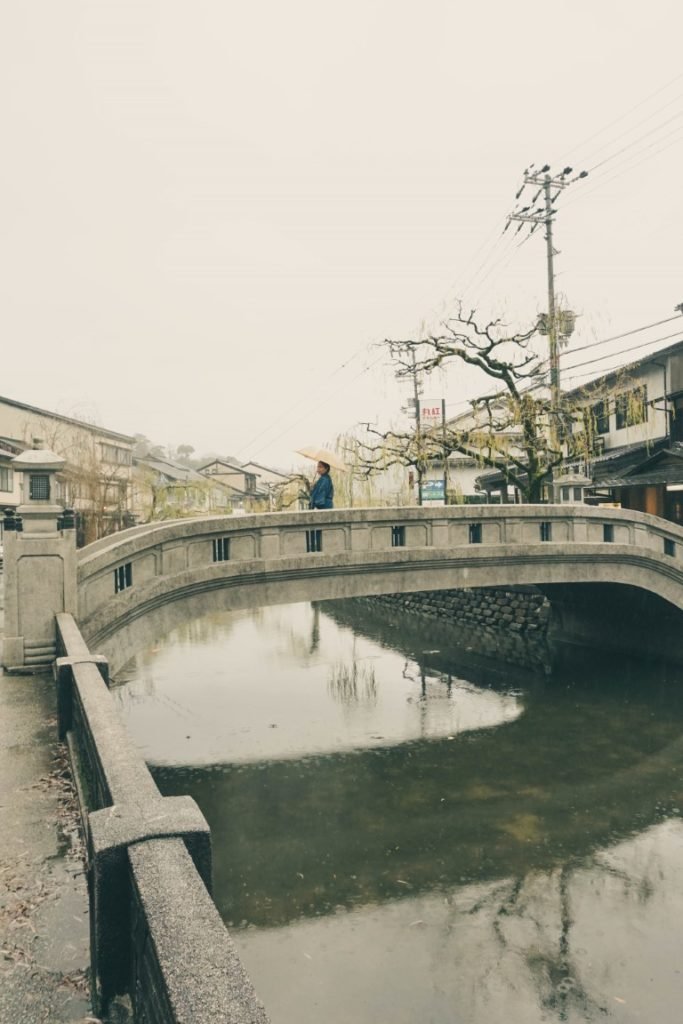
Kinosaki Onsen Price
Visiting Kinosaki Onsen is not cheap. But it doesn’t have to be expensive either. Of course, your choice of where to stay, eat, and buy will determine how much you’ll spend. In our case (family of 4), this is the breakdown of our budget:
Transportation: JR Pass Tickets
We came from Kyoto, about 2.5 hours from Kinosaki, via JR Pass. We took JR limited express train #5 as the others are 3-hour trips. We spent ¥4,400 each, broken down into ¥2,640 for the ticket and ¥1,760 for seat reservations. Going back to Kyoto costs the same. When we arrived at the Kinosaki Onsen station, there was a free shuttle bus that dropped us off near our ryokan.
Total: ¥35,200 (2 sets of 1-way tickets for 4 persons)
Accommodations: Kinsui
We booked Kinsui for one traditional room with 4 twin futons costs around ¥17,000 per night. With a city tax of ¥350 per person per night, the total was around ¥20,000.
Total: ¥20,000 (1 room, 4 persons, 1 night)
READY TO BOOK A ROOM?
Ryokan Kinsui
Meals: Gibugabu and Inaba Sengyo
Dinner at Gibugabu costs ¥11,000, only because we ordered expensive Tajima beef dishes (the steak was ¥5,000, and the steak rice bowl was ¥2,800). Inaba was around ¥4,800. We also bought traditional Japanese snacks and ice cream at Kinosaki Kinako (¥1,400) and cheese tarts (¥800).
Total: ¥18,000
Onsen Pass
Our stay at Kinsui already includes a free pass (the ticket is called Yumepa) with unlimited access to all 7 onsens until check-out. If you’re not staying overnight, you can buy an unlimited Yumepa for ¥1,300 or to individual onsens at ¥700 each.
Total Kinosaki Cost
All told, we spent around ¥73,200. That’s not exactly cheap. But it’s pretty reasonable, given the overall experience.
The JR Pass tickets are more or less the same. Kinsui is already the best deal in town. The only way you can keep your cost lower is if you skip more expensive meals. But then, you’ll miss out on possibly your only chance to eat Tajima beef in the region where it’s raised.
Where is Kinosaki Located?
Kinosaki Onsen is located in the northern Hyōgo Prefecture on the Sea of Japan coast. It’s now part of the city of Toyooka.
It’s easily accessible by train from Kyoto, Osaka, Kobe, and Himeji via Limited-Express JR trains (Sanin Main Line). It took us only 2.5 hours from Kyoto. You can take the free shuttle from the Kinosaki station, or you can just walk to the town center (around 10 minutes).
If you’re flying, the closest airport is Konotori Tajima Airport, and then take the 45-minute bus ride to Toyooka’s city center. From there, take another 10-minute bus ride to Kinosaki.
The entire town is compact. You can walk the entire stretch of Kinosaki Onsen in 15 to 20 minutes.
Kinosaki Onsen Itinerary With Kids
One or two nights in Kinosaki Onsen is enough to have the full onsen hopping experience. This was our itinerary for 2 days and 1 night:
Day 1
| 11:00 AM | travel to Kinosaki |
| 3:00 PM | check in Kinsui |
| 3:30 PM | stroll in Kinosaki |
| 5:30 PM | back to Kinsui |
| 6:00 PM | onsen (Satono-Yu) |
| 7:30 PM | dinner (Gibugabu) |
| 9:00 PM | onsen (Mandara-Yu); back to Kinsui |
Day 2
| 6:00 AM | get ready, breakfast |
| 7:00 AM | onsen (Kouno-Yu) |
| 9:00 AM | pack up, check out |
| 10:00 AM | stroll |
| 12:00 PM | lunch (Inaba) |
| 3:00 PM | go to station |
| 3:30 PM | travel to Kyoto |
Kinosaki Onsen FAQs
Is Kinosaki Onsen kid-friendly?
Yes, Kinosaki Onsen is kid-friendly. Children must be accompanied by an adult at all times. And if they’re under 10, they can enter the onsen of the opposite gender.
Our kids were 7 and 12 when we visited. At first, they were nervous about going to a public bathhouse, naked and afraid. But after the initial shock, they just went about their business like locals.
It might be a different scenario if you have teenage or adult children, especially boys. In that case, just go to a different onsen separately. It’s a lot less traumatic to see naked strangers than for them to see their naked dad!
Of course, there is more to Kinosaki Onsen than onsen hopping. Our children enjoyed eating matcha ice cream, cheese tarts, and Japanese snacks while strolling along the streets. They also loved wearing a yukata and geta, splashing puddles during a drizzle. And sleeping on a futon on tatami mats was a fun experience for them.
So definitely bring along your kids. It’s a one-of-a-kind experience they’ll remember for a long time.
Are foreigners allowed in an onsen?
Yes, this is a tourist destination. While you’ll find a lot of locals in an onsen, there are also plenty of foreign tourists here (they’re the ones in yukatas!). Kinosaki Onsen is very tourist-friendly, with most signs in English and locals who speak some English.
Is Kinosaki Onsen tattoo-friendly?
Tattoos are associated with the yakuza (Japanese mafia), so most onsens do not allow guests with tattoos. However, Kinosaki Onsen is tattoo-friendly. Now, if your 10-year-old has a tattoo, that’s another problem!
Do you wear clothes in an onsen?
No, you’re butt-naked along with strangers. There are separate locker rooms and onsens for males and females. The Japanese are so used to this. Don’t be conscious because no one cares and no one stares.
How to bathe in an onsen?
There are rules and etiquette to follow when bathing in an onsen. Some quick tips:
- Bring your own towel, courtesy of your ryokan.
- Don’t bring a camera, or leave it in the locker. Photos are not allowed inside the bath area.
- Get naked. No swimsuit allowed.
- Don’t stare.
- Wash your entire body first with soap and rinse before dipping in the onsen. There are small stalls where you sit on a stool to wash up.
- You’ll be given a small towel for drying yourself up. Fold it and place it on your head like what locals do or set it nearby.
- Cover your privates with your small towel as you move across the room.
- Ensure it doesn’t fall into the water, as it’s considered unclean.
- Don’t let your hair get wet in the onsen. Don’t dunk your head underwater.
- Don’t swim. It’s not a pool. Just relax.
- Try different baths in the onsen.
- Wipe yourself dry before entering the locker room.
Is there anything else to do aside from onsen?
Yes, aside from onsen hopping, eating, strolling, and shopping, there are other activities you can do in Kinosaki.
Kinosaki Ropeway
Ride the cable car of the Kinosaki Ropeway to see a spectacular view from Mount Daishi. Midway to the next station, check out Onsenji Temple. The custom before was to visit the temple, pray for permission, and get a special ladle before entering the hot springs. We skipped this activity for lack of time. It’s not a must-do.
Retro Arcades
You’ll find a number of retro-style Japanese arcades in Kinosaki. You can play with vintage pachinko slots, pinball machines, and shooting galleries.
When to Visit Kinosaki Onsen
Here are the different seasons to consider when visiting Kinosaki Onsen:
Spring: Late March to May
Early to mid-April is cherry blossom season. The weather around that time is still cool. Late April is also the time for the Onsen Festival, commemorating Kinosaki’s founder Dochi Shonin. Spring is probably a good choice because of the cherry blossoms (but this means Tokyo and Kyoto will be more crowded).
Summer: June to August
Summer is when it’s hottest in Kinosaki. But this is the time for summer festivals, including the Furosato Festival, when you get to enjoy the fireworks display at night. Kinosaki Onsen has small fireworks displays every night for a month. The atmosphere is also livelier with yatai (food booths) lined up selling tako-yaki, yaki-soba, and karaage. But for a peaceful experience, summer may not be the best time to go to an onsen town. It’s too hot to enjoy dipping in the hot springs.
Autumn: September to November
The weather is cooler, and the fall foliage is pretty. There are also festivals called danjiri matsuri during this time, particularly in October. Kinosaki Onsen has staged fights where they build lavishly decorated portable shrines, which they put against one another. Autumn would be a good time to visit, but we would avoid the week of the festival because of the crowds (you want to relax in an onsen town, not get overstimulated).
Winter: December to March
There can be snow around this time, and Kinosaki looks gorgeous in the snow. But when and how much it will snow is unpredictable. This is also a popular time to visit Kinosaki because of the crab season.
We went mid-December when it was a bit cold and drizzling (not snowing), but that made it dipping in the onsens more relaxing. However, there were also no cherry blossoms, but the weeping willows made up for it.
There were some crowds during the day, but by late afternoon until early morning, it felt like we had Kinosaki Onsen all to ourselves (and a few other tourists). The onsens were not packed, so there was always plenty of room. The restaurants and shops were half-empty, so you don’t feel rushed.
For us, winter is the best time to visit Kinosaki Onsen.
Is Kinosaki Onsen Worth Visiting?
We would highly recommend visiting Kinosaki Onsen. It is truly one of the best onsen towns in Japan. It offers a full, immersive experience. You get 7 distinct public bathhouses, stay at an authentic ryokan, enjoy the charming old-world architecture, wear a yukata while strolling, feast on local cuisine, relax in an onsen, and get transported to another time.

